Can You Tattoo White Over Black?
Tattooing involves injecting ink into the skin to create a permanent design or image. While black ink is one of the most commonly used colours for tattoos, some people may want to add white ink to their existing tattoos or cover up a black tattoo with white ink. So, can you tattoo white over black?
Yes, it is technically possible to tattoo white over black, but there are some important factors to consider. Firstly, the black ink should be fully healed and not raised or scabbed, as this can make it difficult for the white ink to take. Secondly, the white ink may appear slightly transparent over black ink, so it is important to choose a skilled tattoo artist who has experience with this technique. Lastly, white ink tattoos can fade more quickly than black ink tattoos, so touch-ups may be necessary.
This article will explore the answer to this question and provide some insights into the process of tattooing with white ink.
Tattoo White Over Black Ink For A Coverup
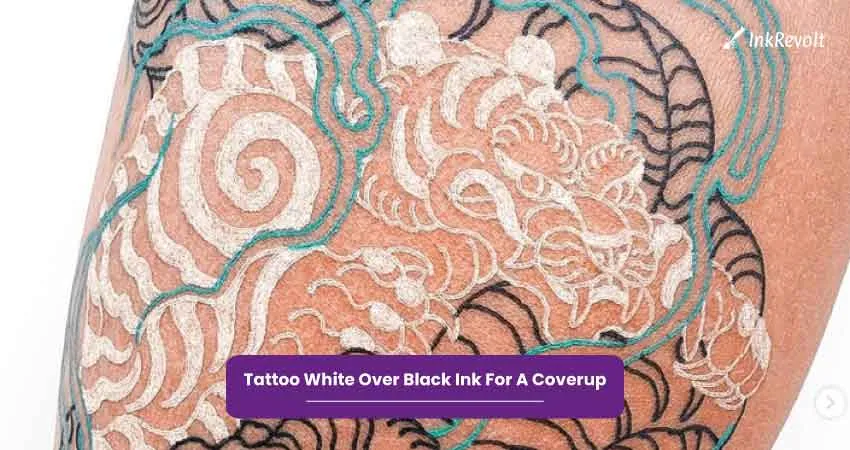
A cover-up tattoo is a design that is used to hide an existing tattoo that the wearer no longer likes or is unhappy with. When covering up a black ink tattoo with white ink, the artist will need to apply several layers of white ink over the existing tattoo to effectively block it out.
The first step is to find a skilled tattoo artist who has experience with cover-up tattoos and can help you choose a design that will effectively hide the old tattoo. Remember that not all tattoos are good candidates for cover-ups, and a skilled artist will be honest about what can and cannot be done.
Once you’re sure about a design, the artist will start by using a stencil to outline the new design over the old tattoo.
Then, they will use a combination of shading, highlighting, and layering to cover up the black ink with white ink. It’s important to note that white ink is not as opaque as black ink, and it may require multiple sessions to achieve full coverage.
After the initial tattoo session, it is essential to take proper care of the tattoo as it heals. This includes following the aftercare instructions provided by the artist, avoiding sun exposure, and keeping the tattoo clean and moisturized.
What Happens If You Tattoo White Over Black?
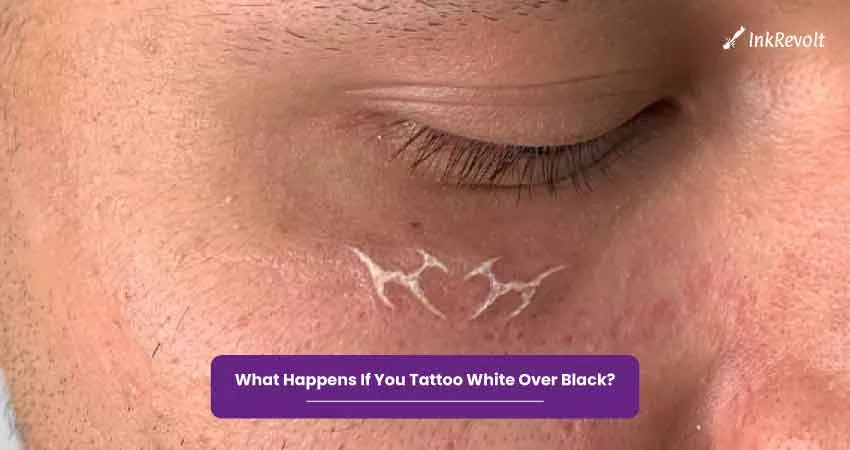
Tattooing white over black is a challenging process that requires the expertise of an experienced tattoo artist. In this process, the artist will use white ink to cover the black ink, and the result will depend on the saturation of the black ink and the skin tone of the individual.
- The white ink may not be visible: White ink is generally used for highlighting and adding details to a tattoo, and it is not as opaque as black ink. When white ink is used over black ink, the black ink may overpower the white ink, making it difficult to see the white color.
- The tattoo may appear grey: When white ink is applied over black ink, the result may be a grayish color instead of pure white. This is because the black ink can mix with the white ink, creating a muted color.
- The tattoo may not age well: Over time, tattoos can fade and blur. When white ink is used over black ink, the contrast between the two colors may become less noticeable, making the tattoo appear muddled and unclear.
- The tattoo may cause skin irritation: Some people may be allergic to the pigments in tattoo ink, and applying white ink over black ink may increase the risk of an allergic reaction. Additionally, the tattooing process itself can cause skin irritation, especially if the tattoo is large or covers a sensitive area.
- The tattoo may not be easily covered up: If you are unhappy with a tattoo that has white ink over black ink, it may be difficult to cover up the design with a new tattoo. The black ink may show through, and the white ink may make it challenging to achieve a clean, crisp design.
Step By Step Process of White Out Technique for Tattooing
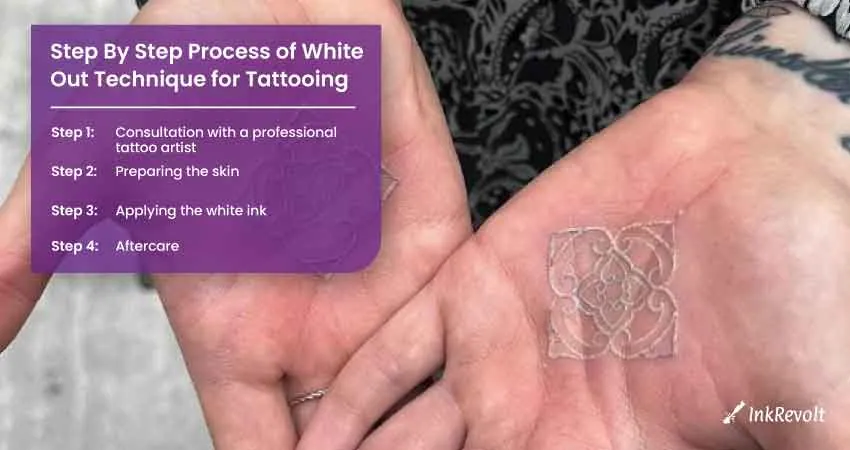
The white-out technique is a tattooing method that involves covering up an existing tattoo with white ink. Let’s go through the step-by-step process now.
Step 1: Consultation with a professional tattoo artist
You need to discuss your goals and expectations with your tattoo artist. They will assess your existing tattoo and recommend the best approach to achieve the desired result.
Step 2: Preparing the skin
The tattoo artist will prepare your skin by cleaning it with an antiseptic solution and shaving the area around the tattoo.
Step 3: Applying the white ink
The tattoo artist will then apply the white ink on the existing tattoo using a needle and a tattoo machine. The process is similar to a regular tattoo, but the ink used is white. The artist will apply several layers of white ink until the old tattoo is no longer visible.
Step 4: Aftercare
The tattoo artist will give you instructions on how to take care of your new tattoo. You should keep the area clean and avoid exposure to the sun, water, and other irritants until the skin is fully healed.
Things To Consider When Getting A White-On-Black Tattoo
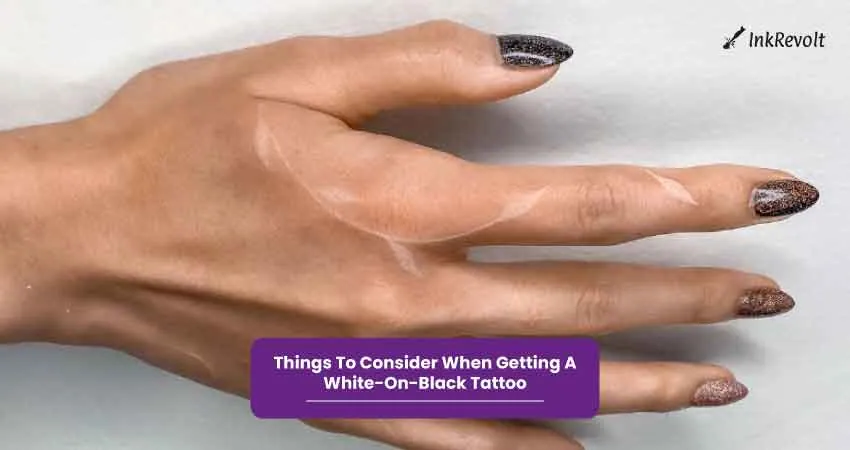
And, there are a few considerations related to getting a white-on-black tattoo you should have a look at.
- Artist Experience: White-on-black tattoos require a skilled artist who has experience working with white ink. Ensure that your chosen tattoo artist has experience working with this type of tattoo.
- Skin Tone: White ink can look different on different skin tones. It is essential to talk to your tattoo artist about your skin tone to determine whether white ink will work well for your complexion. As a solution skin tone inks can be used.
- Design: The design of a white-on-black tattoo needs to be unique and bold. Since the white ink does not show up as well as black ink, it is essential to choose a design that is bold and easily visible.
- Touch-Ups: White-on-black tattoos are known to require more touch-ups than traditional tattoos. Ensure that your artist is willing to offer touch-ups for free or for a reduced price if needed.
- Healing Process: White-on-black tattoos may have a more extended healing process compared to traditional tattoos. It is essential to follow the aftercare instructions provided by your tattoo artist to ensure proper healing.
Some Drawbacks Of Partially Lightening A Tattoo With White Tattoo Ink
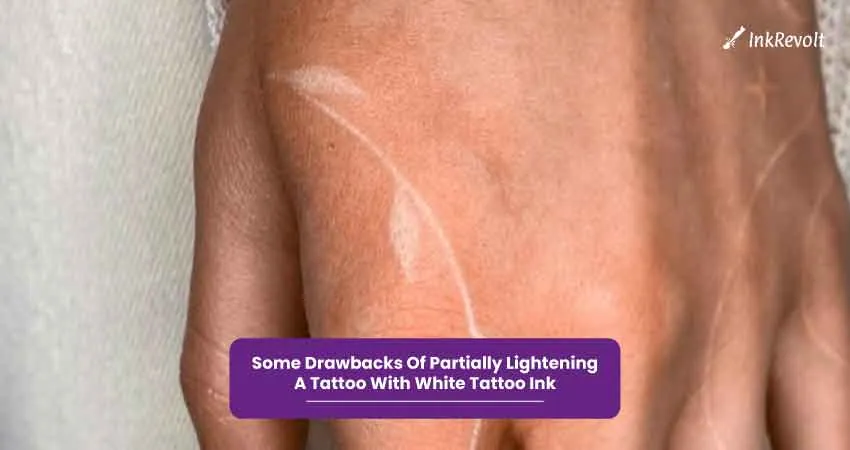
There are some drawbacks to consider before choosing this method.
- Inconsistency in Color: One of the major drawbacks of using white tattoo ink to lighten a tattoo is that it can lead to inconsistency in colour. The white ink can mix with the existing tattoo ink, making it difficult to achieve a consistent color throughout the design.
- Limited Effectiveness: Partially lightening a tattoo with white ink may not be effective for all tattoos, particularly those with dark, thick lines or heavily saturated colors. The white ink may not be able to completely cover up the existing tattoo, leading to a patchy, uneven result.
- Potential for Discoloration: There is also a risk of discoloration when using white ink to lighten a tattoo. Over time, the white ink may be yellow or fade, leading to a less attractive result.
- Longer Healing Time: Partially lightening a tattoo with white ink may require multiple sessions and longer healing time compared to traditional tattooing. This can be inconvenient and may require additional care during the healing process.
- Limited Options: Finally, there may be limited options for design when using white ink to lighten a tattoo. The technique works best for simple designs or those with a lot of negative space, and may not be suitable for more complex tattoos.
Alternatives To Tattooing White Over Black For A Coverup
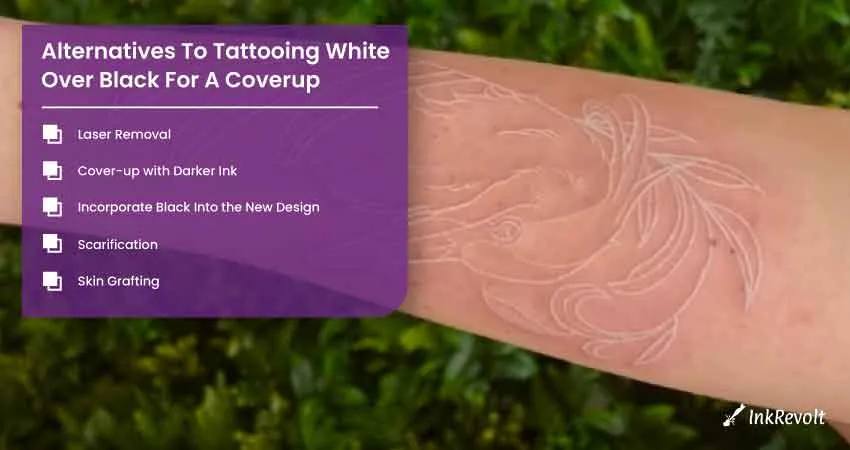
Tattoo cover-ups are a popular way to get rid of an old, unwanted tattoo and replace it with a new one. However, covering up a black tattoo with white ink can be a challenging task as the ink can fade over time, making it difficult to maintain the desired look. Luckily, there are several alternatives to tattooing white over black for a cover-up.
Laser Removal
Laser tattoo removal can lighten the existing black ink and create a clean canvas for a new tattoo. It may require multiple sessions, but it is a safe and effective method.
Cover-up with Darker Ink
A professional tattoo artist can cover the existing black ink with a darker ink, creating a new design that blends well with the original tattoo.
Incorporate Black Into the New Design
Another option is to incorporate black ink into the new design. A skilled artist can create a design that integrates black ink, making it an integral part of the new artwork.
Scarification
Scarification is the process of creating a permanent scar design on the skin. It can be used to cover up tattoos by creating a new design on the skin. However, this method can be painful and should be done by an experienced professional.
Microdermabrasion
Microdermabrasion is a non-invasive method of removing the top layer of skin, which can help lighten the existing tattoo. However, it is not a permanent solution and may require multiple sessions.
Skin Grafting
In extreme cases, skin grafting can be used to cover up tattoos. This method involves removing the tattooed skin and replacing it with healthy skin from another part of the body. This method is generally not recommended due to its invasive nature.
Tattoo White Ink Into A Blackout Tattoo?

Tattooing white ink over a blackout tattoo can create a unique and subtle effect. The white ink may appear more muted and may not be as visible as it would be on lighter skin or on a non-blackout tattoo. It’s essential to find a skilled and experienced tattoo artist who knows how to work with white ink and has experience with blackout tattoos.
White ink tattoos require a lot of care and attention to maintain their color and avoid fading. It’s crucial to follow the aftercare instructions provided by the artist and protect the tattoo from direct sunlight and water.
Blackout Tattoos With White Ink; How Do They Age?
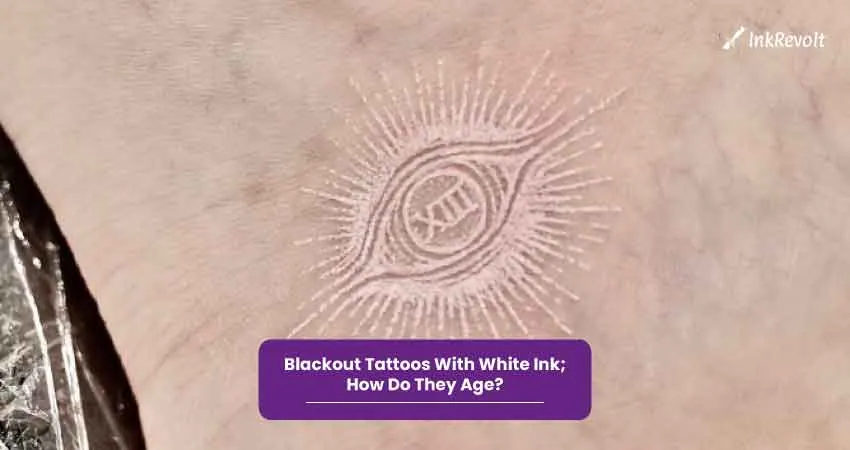
While white ink tattoos may seem like a good option for those who want a more subtle and hidden tattoo, it’s important to understand that they can be difficult to execute and may not age as well as traditional black ink tattoos.
White ink is typically thinner and less opaque than black ink, meaning it can fade and blur more easily over time. This can result in the design appearing less crisp and defined, potentially blending in with the surrounding black ink.
Additionally, the process of covering a large area of skin with solid black ink can be more traumatic to the skin than a smaller, more detailed tattoo. This can increase the risk of scarring and other long-term skin damage.
Ultimately, the longevity and appearance of a blackout tattoo with white ink will depend on a variety of factors, including the skill of the artist, the quality of the ink used, and the care taken in aftercare and healing.
It’s important to carefully consider these factors before deciding on this type of tattoo, and to work with a reputable artist who can guide you through the process.
Frequently Asked Questions
Is it safe to tattoo white over black?
Yes, it is safe to tattoo white over black, as long as the tattoo artist follows proper safety precautions and maintains good hygiene practices.
Will the white ink show up on black skin?
White ink is not as visible on black skin as it is on lighter skin tones. The contrast between the white ink and the black ink will be less noticeable on black skin, and the white ink may appear more muted or grayish.
Can white ink fade or turn yellow over time?
Yes, white ink can fade or turn yellow over time. White ink is more prone to discoloration than other ink colors and can fade to a yellow or brownish color over time.
Can white ink cause allergic reactions?
Like any tattoo ink, white ink can cause allergic reactions in some people. It is important to do a patch test before getting a tattoo, especially if you have sensitive skin or a history of allergies.
Wrapping Up
Have you got your answer to the question “Can you tattoo white over black?”
We hope you answered “yes” now that we’ve covered everything there is to know about the topic.
Tattooing white over black ink is possible, but it requires an experienced and skilled tattoo artist. The process of covering up black ink with white ink involves multiple sessions and careful consideration of the design and placement. You’ll be pleased with the outcomes if you’re patient and follow the regulations!
